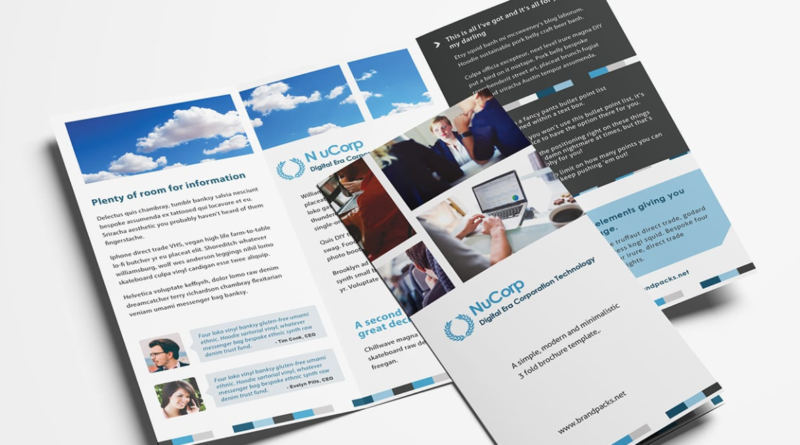Sustainability in Brochure Design: Eco-Friendly Options
In today’s environmentally conscious business landscape, sustainability has emerged as a critical priority for companies seeking to reduce their carbon footprint and demonstrate their commitment to environmental stewardship. As organizations strive to adopt more eco-friendly practices, the design of marketing collateral, such as brochures, presents a valuable opportunity to showcase their sustainability initiatives and align their visual identity with green business goals. Brochures, as a tangible representation of a company’s brand and messaging, can serve as an effective platform to communicate the organization’s sustainability efforts to both internal and external stakeholders.
By incorporating environmentally responsible design elements and materials into brochure design in dubai, businesses can not only minimize the environmental impact of their marketing materials but also reinforce their reputation as responsible corporate citizens. This overview will explore the growing importance of sustainability in business practices, highlighting how brochure design can contribute to a company’s sustainability efforts. The purpose is to provide guidance on eco-friendly options in brochure design that can help organizations achieve their green business objectives and demonstrate their commitment to environmental protection.
The Importance of Sustainability in Marketing Materials
The environmental impact of traditional printing practices has long been a source of concern, with the industry’s heavy reliance on paper, ink, and energy-intensive production methods contributing to significant ecological challenges. From deforestation and greenhouse gas emissions to the generation of harmful waste, the traditional printing model has struggled to align with the growing global emphasis on sustainability. However, the emergence of sustainable marketing practices has presented a promising solution to this dilemma.
By embracing eco-friendly strategies, companies can not only mitigate their environmental footprint but also enhance their brand image and cultivate deeper trust with conscientious consumers. Leading organizations in this space have demonstrated the power of sustainable marketing, showcasing innovative approaches that prioritize resource conservation, renewable materials, and carbon-neutral production. For instance, outdoor apparel brand Patagonia has long been recognized for its commitment to environmental stewardship, incorporating recycled and organic materials into its product lines and advocating for responsible resource management. Similarly, tech giant Apple has made significant strides in reducing the carbon footprint of its operations, with a focus on renewable energy sources and closed-loop manufacturing processes. These companies’ dedication to sustainability has not only resonated with eco-conscious consumers but has also positioned them as industry leaders, enhancing their brand reputation and customer loyalty. Also, Read The Benefits of Lip Reduction Surgery in Abu Dhabi
Eco-Friendly Materials for Brochure Design
Recycled Paper Options
When choosing recycled paper for professional use, consider the options: Post-consumer waste (PCW) paper is made from used office paper, newspapers, and other waste. PCW is an eco-friendly choice that diverts waste from landfills. Many PCW papers are bleached without harsh chemicals. Agricultural waste papers, made from byproducts like cotton or bamboo, have a distinctive textured look. They are durable and suitable for various business uses. Select recycled papers with a smooth, consistent surface and appropriate weight/opacity for clear legibility. Doing so demonstrates a commitment to sustainability and professionalism.
Sustainable Inks
Vegetable-based and soy-based inks are emerging as alternatives to traditional petroleum-derived inks. These innovative inks offer advantages that make them attractive for eco-conscious businesses and consumers. Vegetable-based inks derived from natural plant oils are more sustainable and environmentally friendly, being biodegradable, renewable, and producing lower volatile organic compound (VOC) emissions. Soy-based inks also leverage renewable, plant-based resources, reducing reliance on fossil fuels and emitting fewer VOCs. The use of low-VOC inks contributes to a more sustainable future while maintaining high-quality printing.
Alternative Printing Materials
Bamboo, hemp, and stone-based papers are emerging as alternatives to traditional wood pulp for brochures and printed materials. These materials offer unique properties and environmental advantages. Bamboo paper is strong, durable, and eco-friendly, requiring less water, fewer chemicals, and lower emissions. Hemp paper is long-lasting, tear-resistant, and naturally white. Stone paper is waterproof, recyclable, and has a distinctive smooth, matte finish. These alternative materials can provide enhanced sustainability, distinctive textures, increased durability, and potential cost savings. However, they may have limited availability, higher initial costs, and compatibility issues with some printing techniques. Weighing the pros and cons can help brochure designers create compelling, sustainable printed materials.
Designing for Sustainability
Minimalist Design Approach
Minimalist design can reduce environmental waste by using less ink and paper. Clean, uncluttered layouts with generous white space, restrained typography, and strategic graphics can convey the same impact with fewer resources. Minimalist brochures feature bold headings, compelling images, and concise body text, or employ grid-based structures with ample spacing. This eco-friendly approach allows organizations to create visually striking and environmentally responsible marketing materials.
Multi-Purpose Brochures
Designing versatile brochures can maximize their lifespan and ROI. Create brochures that serve multiple marketing needs, like sales meetings, events, and client onboarding. Use flexible design elements and timeless content to maintain relevance. This versatile approach yields lasting value from promotional materials.
Reducing Brochure Size
Compact brochure formats offer benefits for businesses and customers. Smaller brochures reduce material usage, lowering costs for production and shipping. This benefits the environment and allows savings to be passed to customers or reinvested. Compact size also enables more efficient packing, storage, and distribution. By carefully designing smaller brochures, businesses can lower costs while delivering effective marketing materials.
Importance of Sustainable Brochure Design
Key points on the importance of sustainable brochure design:
Designing eco-conscious brochures is crucial for aligning marketing with responsible practices
Sustainable brochure production reduces carbon footprint, conserves resources, and conveys green commitment
Incorporating sustainable materials, printing, and design demonstrates a company’s environmental dedication. Encouragement for businesses to adopt eco-friendly brochure options
Sustainable brochures position companies as socially and environmentally responsible
Eco-friendly materials and minimalist design reduce waste and appeal to conscious consumers
Sustainable brochure design differentiates brands and builds loyalty. Future of sustainable brochure design and responsible business practices
Environmental awareness will drive increased demand for sustainable brochure design
Integrating eco-principles into marketing is a fundamental aspect of responsible business
Embracing sustainable brochure design demonstrates environmental stewardship and fosters stakeholder connections.

